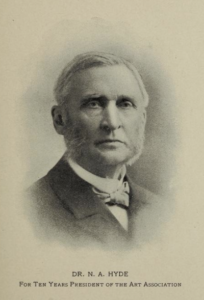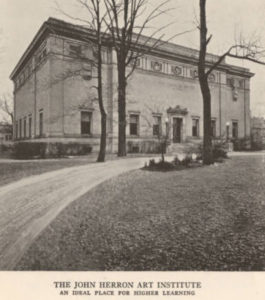Theodore Clement Steele, American, 1847–1926
1893
Oil on canvas
114.93 cm x 86.99 cm | 45.25 in x 34.25 in
Framed: 147.32 cm x 120.01 cm | 58 in x 47.25 in
Signed and dated, lower left: T.C. Steele / 1893
With permission, Indianapolis Museum of Art, John Herron Fund
Accession Number: 95.2
Commissioned by the Art Association of Indianapolis
Nathaniel A. Hyde (1827-1901) was a founding member and president of the Art Association of Indianapolis from 1883-1893.
He married Laura K. Fletcher, daughter of Stoughton A. Fletcher, Sr. (Stoughton Fletcher was son of Calvin Fletcher and brother of Dr. William B. Fletcher). Hyde graduated from Yale in 1847 and Andover Theological in 1851.¹
Hyde was also a pastor at Plymouth Church (1858-1867) in Indianapolis and later Mayflower Church, also of Indianapolis which was founded on May 23, 1869. Hyde served as pastor of Mayflower Church from 1873-1888 and as emeritus until his death in 1901. After his retirement from the church, much of his time was devoted to the charity work of the city, the Art Association, and other interest of a public character, as well as interests in the Congregational Church.¹
Hyde was born on May 10, 1827 in Stafford, Connecticut of Pilgrim stock. The “Alden” in his name being for John Alden, of “Mayflower” fame, of whom he was a descendant on his mother’s side.¹ Some sources state that his mother Caroline (Converse) Hyde’s family were descendants of John and Priscilla Alden.
The Art Association of Indianapolis was founded more than 130 years ago. In 1883, May Wright Sewall, along with 17 other residents of the city, signed the articles of incorporation to fund the Art Association of Indianapolis.
Also a prominent suffragette and principal of the Girl’s Classical School, May Wright Sewall stated;
Nothing is so cosmopolitan in its tendency as art; where it flourishes, the provincial spirit declines; sect and party lines become faint as it becomes dominant. The art spirit is by no means dominant in Indianapolis, but it is felt as a vital force.²
In 1895, the Association received a $225,000 gift from the estate of real estate investor John Herron to build a permanent art gallery and school and the Tinker House Talbott Place home and studio of T.C. Steele was selected as the new site.²
The cornerstone of the new building was laid in an afternoon ceremony on Saturday, November 25, 1905 at Pennsylvania and 16th Streets. The exercises preceding the setting of the stone were held in the Mayflower Congregational church, (Delaware and 16th Streets) beginning at 2 o’clock. T. C. Steele was a featured speaker at the event.³
The Indianapolis News had extensive front page coverage of the ceremony in the Saturday, November 25, 1905 issue. Below is the text of Steele’s remarks:
Work of Now The Important Thing Says T.C. Steele
He Sets Out the Immediate Purposes of the Art Institute – Touch With Life.
T.C. Steele, the artist, said:
“It is a great thing to start a city and to start a State along the line of serious art in our modern day. Art is touching life at many points, industrially, aesthetically and as our interpreter of life and nature, its need is growing greater every day. It is our belief that the John Herron Art Institute is to be no inconspicuous factor in art’s development in this city and State. John Herron is the silent partner who has given the capital to at last start this beneficent enterprise. The public is the other partner, and the Art Association trustee for both. A generous recognition and response upon the part of the pubic, energy and wisdom upon the part of the association, are the essential factors in the institute’s success. As we believe in this enterprise, we believe these factors can not fail.
“It is not my intention I speaking of the future of the institute to draw any rose-colored vision of what it may become in the distant future. That institute that serves i8ts day and generation best is not likely to tail in growth and perpetuity. So it is my intention to speak of things we hope to do and are planning to do now.”
Center of the State’s Art Activities
“In a general way it is our intention to make the institute the center of the art interest and activities of the city and State. To do this we shall work in three directions. In the first place we shall expect to take care of current exhibitions. We shall secure and present in properly lighted galleries the best of contemporary art. These exhibitions will be constantly changing and will be not only a source of enjoyment but a school for the people. The appreciation of the best in art comes only from seeing the best. Art criticisms and lectures in art have their place. They give information and awaken interest, but the message of a work of art, that which is vital and gives it its quality, come only from the work itself. So it is not too much to claim that these constantly recurring exhibitions will become the art school of the people.
“The second direction in which we expect to work is in building up a permanent collection of high character. This we will do by purchase and by gifts. We already have made a fair commencement in this direction. Some of our recent purchases, especially, would honor the walls of any museum in our land.
Breadth of the Art School
“In the third phase, we expect to develop and strengthen the art school now started. As this is one of the most important of our intentions, it is also one of the most difficult to carry into execution, for it is the desire of the management to include not only the education of the draftsman, the painter, the sculptor, but to enter the field of design and industrial and applied art. The revival of the handcrafts, the better taste and design in the products of manufacture, the bringing back of beauty to things of utility, is one of the most significant signs of the times.
“It is not in any sense a fad, but is manifesting itself in well-considered efforts in every progressive country of the world. It is bringing back art to the people from whom it has been long divorced. I wish to speak for the sympathetic encouragement for our efforts in this direction.
“These are some of the things we plan to do and when they are complete others will be suggested, no doubt.
“I know I voice the intention of the Art Association and the director elected to do this work, when I say they expect to make the John Herron Art Institute a live force in this community. To do the work that is at hand and to plan so broadly that future growth will not be impeded.
“This is the policy of wisdom and is the best assurance of present success and the perpetuity of the institution.”4
On November 20, 1906, the John Herron Art Institute formally opened its doors in a building designed by the Indianapolis architecture firm of Vonnegut & Bohn.
In 1964 Herron’s Museum was out of space. News that some sites outside downtown were being considered prompted a firestorm of public criticism. An advisory company was hired and when their report was received, the board was advised to build downtown unless they were given land elsewhere “free and clear.”⁵
In 1966, Ruth Lilly, daughter of Josiah K. Lilly, Jr. donated her parent’s estate Oldfields (38th & Michigan Road) to the Art Association to be used as a site for a new museum, the present day site is named Newfields.⁵ Ruth was the daughter Josiah K. Lilly, Jr., and the great granddaughter of Eli Lilly, founder of the Eli Lilly and Company pharmaceutical firm founded and headquartered to this day in Indianapolis, Indiana.
In 1969, The Art Association of Indianapolis changed its’ name to Indianapolis Museum of Art. Today, the Museum of Art sits on a 152 acre Newfields campus filled with art and nature.⁵
Reverend Nathaniel Alden Hyde is buried in Crown Hill Cemetery in Indianapolis.
1 Greater Indianapolis: The History, the industries, the institutions, and the people of a City of Homes, Vol. 1, Pg. 605, Jacob Piatt Dunn, Unigraphic, 1910, digitized, August 18, 2016.
2“T. C. Steele Studio and Herron.” Indiana Historical Bureau. Accessed May 5, 2020. https://www.in.gov/history/markers/4259.htm.
3“Corner Stone Laying of the John Herron Art Institute.” The Indianapolis News, November 22, 1905. https://www.newspapers.com/image/?clipping_id=50274662.
4“Work of Now The Important Thing Says T.C. Steele.” The Indianapolis News, November 25, 1905. https://www.newspapers.com/clip/50286481/the-indianapolis-news/.
5“History.” Newfields. Accessed May 5, 2020. https://discovernewfields.org/about/history.






